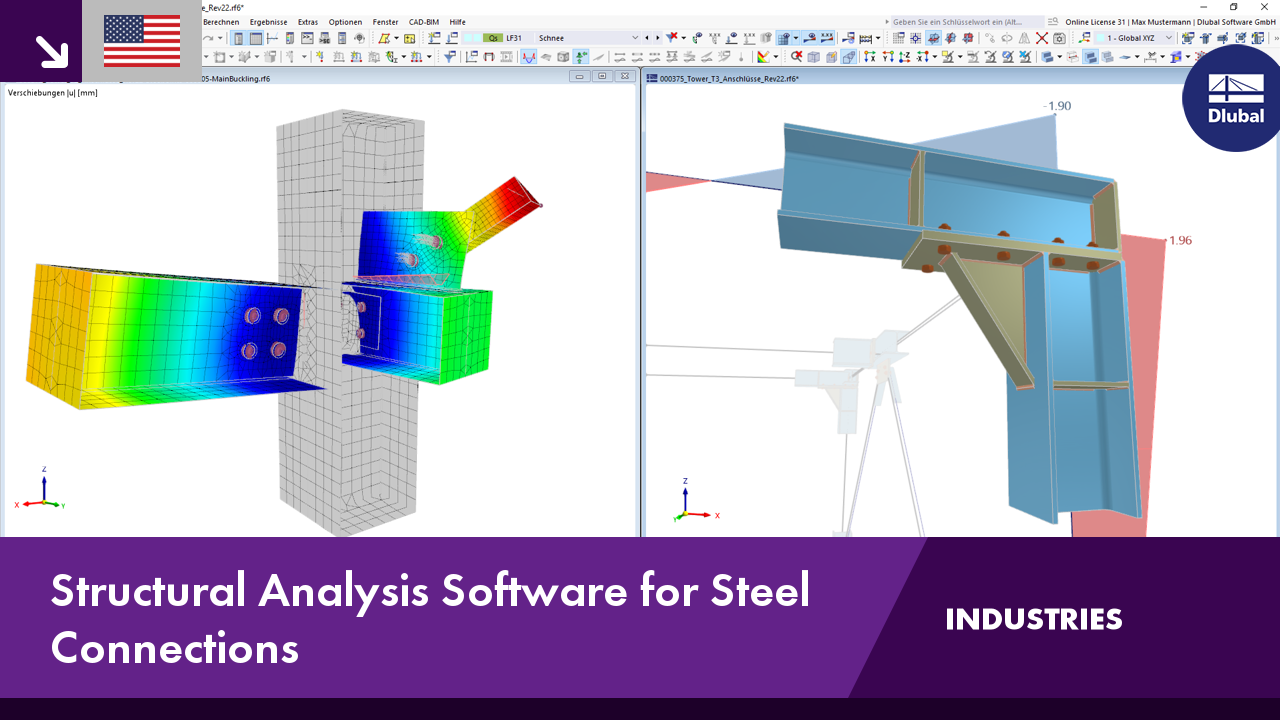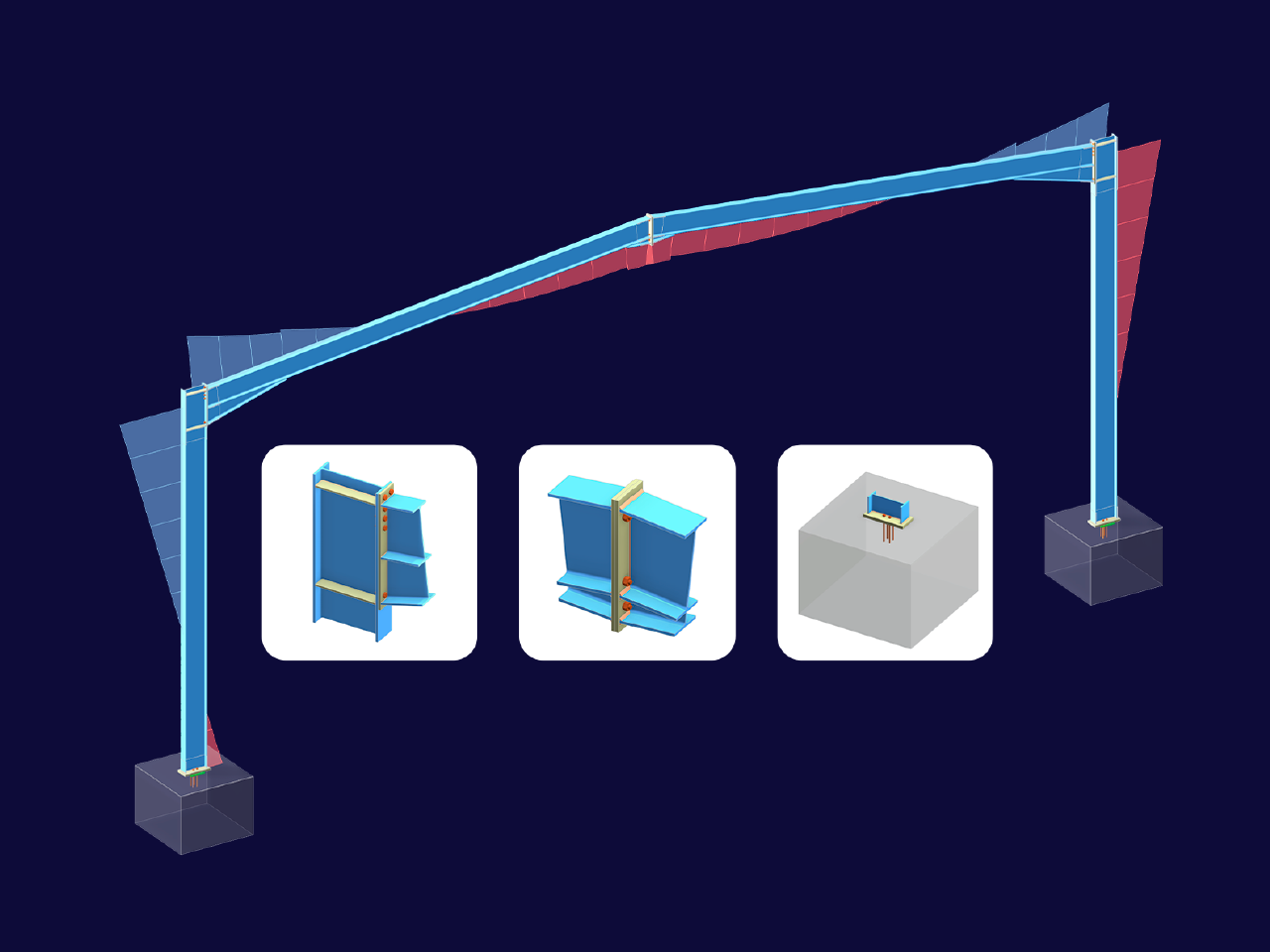Introduction
Within RFEM 6 and the Steel Design Add-on, lateral-torsional buckling (LTB) is considered when designing steel beams after defining the effective lengths under the Design Types tab of the member. There are a couple of stability analysis methods to choose from. The first method is calculating LTB according to the AISC 360-22 [1] standard, Chapter F. The second method is to have RFEM perform an eigenvalue analysis to calculate the governing stability conditions and the elastic critical moment (Mcr). These determination methods are selected when creating an Effective Lengths definition under the Design Types tab of members.
Chapter F
In the AISC 360-22 [1] standard, Chapter F, the Modification Factor (Cb) is calculated on the basis of the maximum moment at the midspan and quarter points along the beam using Eqn. F1-1. The unbraced length (Lr) and the limiting laterally unbraced length (Lb) must be calculated as well. For example, referring to F.1-2b taken from the AISC Verification problems [2], a W18X50 cross-section includes an applied uniform load. This, along with the loading criteria, can be viewed in Figure 2. The material, Steel A992, will be used for the beam along with lateral restraints at the ends and third points. The self-weight of the beam will not be considered. Verified with hand calculations below, the Steel Design Add-on can be used to calculate the nominal flexural moment (Mn). This value is then compared to the required flexural strength (Mr,y).
First, the required flexural strength is calculated.
Mu = (ω ⋅ L2)/8
Mu = 266.00 kip ⋅ ft
Now, the lateral-torsional buckling modification factor (Cb) must be calculated for the center segment of the beam utilizing Eqn. F1-1 [1].
|
Cb |
Lateral-torsional buckling modification factor for non-uniform moment diagrams |
|
Mmax |
Absolute value of the maximum moment in the unbraced segment |
|
MA |
Absolute value of the moment at the quarter point of the unbraced segment |
|
MB |
Absolute value of the moment at the centerline of the unbraced segment |
|
MC |
Absolute value of the moment at the three-quarter point of the unbraced segment |
Cb = 1.01
The lateral-torsional buckling modification factor (Cb) must be calculated for the end-span beam utilizing Eqn. F1-1 [1].
Cb = 1.46
The higher required strength and lower Cb will govern. Now, the limiting laterally unbraced length (Lb) for the limit state of yielding can be calculated.
|
Lb |
Limiting laterally unbraced length for the limit state of yielding |
|
ry |
Radius of gyration about the y-axis |
|
E |
Modulus of elasticity |
|
Fy |
Yield strength |
Lb = 69.9 in. = 5.83 ft.
Using Eqn. F2-6 [1] for a doubly symmetric I-shaped member, the limiting unbraced length for the limit state of inelastic lateral-torsional buckling is equal to:
|
E |
Modulus of elasticity |
|
Fy |
Yield strength |
|
J |
Torsional constant |
|
Sx |
Elastic section modulus taken about the x-axis |
|
ho |
Distance between the flange centroids |
Lr = 203 in. = 16.92 ft.
Now, the flexural yielding and inelastic lateral-torsional buckling limit state must be compared to determine which is controlling. The lesser controls (Lp < Lb ≤ Lr) which is used in the nominal flexural strength (Mn) calculation.
|
Cb |
Lateral-torsional buckling modification factor for non-uniform moment diagrams |
|
Mp |
Plastic flexural strength |
|
Fy |
Yield strength |
|
Sx |
Elastic section modulus taken about the x-axis |
|
Lb |
Distance between braces |
|
Lp |
Limiting laterally unbraced length for the limit state of yielding |
|
Lr |
Limiting laterally unbraced length for the limit state of inelastic lateral-torsional buckling |
Mn = 339 kip-ft
Lastly, available flexural strength (φbMn) equal to 304 kip-ft.
Eigenvalue
The second analysis method utulizes an eigenvalue or Euler buckling analysis that predicts the theoretical buckling strength of an elastic structure, or in the case, a single beam member. When buckling takes place, eigenvalues are used to describe the values of loads. Then, eigenvectors are used to determine the shape of the eigenvalues that we calculated. When the resultant structure stiffness reaches zero, buckling takes place. The stress stiffness caused by a compressive load is removed from the elastic stiffness for this scenario. In most circumstances, the first few buckling modes are of the most interest [3]. Since an eigenvalue buckling analysis is theoretical and predicts the buckling strength of an elastic structure, this method is a more exact and differs from the AISC 360-22 [1] leading to a less conservative moment (Mcr) value.
Comparison
When comparing the results between the Steel Design Add-on and the verifcation example F.1-2B [2] from the AISC 360-22 [1], the difference is neglegable and due to increased accuracy in values in RFEM 6. The results are compared below in Images 4 and 5. At the bottom of this article, the model is available for download and testing.
With the Steel Design Add-on, it is possible to also run an eigenvalue analysis when calculating LTB. Example F.1-2B [2], refenced above, was modeled in RFEM and the results were calculated. In Image 06 below, Mcr from the eiganvalue analysis is shown.
The same value calculated from the AISC Design Examples was calculated as:
φbMn = 304 kip-ft
Mn according to Chapter F. [1] in the Steel Design Add-on varies when compared to Mn from an eigenvalue analysis. Fundamentally, the AISC 360-22 [1] standard takes a more conservative approach with analytical calculations compared to an eigenvalue analysis, which is a more theoretical and exact approach. Ultimately, it is up to the engineer's discretion which method or approach is suitable for member design. Chapter F. calculations are likely required, but an eigenvalue analysis can provide a second look at LTB design from a theoretical standpoint for additional member capacity.
Steel AISC verification problems from Chapter F. can be found on Dlubal Software's website, where more details are shown comparing hand calculations to the results from the Steel Design Add-on. These are available in the links below along with the model.
























.png?mw=350&hash=c6c25b135ffd26af9cd48d77813d2ba5853f936c)
















.png?mw=512&hash=4a84cbc5b1eacf1afb4217e8e43c5cb50ed8d827)


















_1.jpg?mw=350&hash=ab2086621f4e50c8c8fb8f3c211a22bc246e0552)






.png?mw=600&hash=49b6a289915d28aa461360f7308b092631b1446e)

















